3D land seismic has generally been limited to sparse survey geometries for both technical and economic reasons. As a consequence, land data can be poorly-sampled and noisy. Combine this with the known challenges of the onshore environment and it is no surprise that image quality is poor compared to marine seismic. This is despite the fact that land acquisition has commonly used wide-azimuth geometries, something from which marine seismic has only recently benefited.
To be more precise, we have been forced to use sparse source and receiver grids designed for adequate sampling of signal only. This means we are regularly recording aliased coherent noise (such as ground roll) which limits the value of the data for processing. Often the primaries at near offsets are damaged during attempts to attenuate the ground roll. Midto- far offsets may also be affected by aliased high-velocity coherent noise such as guided waves, rendering them useless for velocity analysis and imaging.
With the advent of high-channel count recording systems, one of the major hurdles for increasing spatial sampling density has been overcome. We are able to deploy dense receiver geometries with small group intervals and compact arrays or even point receivers. This allows us to record unaliased signal and noise and therefore do a much better job with noise attenuation during processing. We can then reap the full benefits of long offsets and wide azimuths for processing and imaging.
There is a need to match this increase in receiver density on the source side. To accomplish this we need a significant increase in source effort while decreasing the source array size. “Higher vibroseis effort should be accomplished by generating more records at frequent source intervals rather than using more sweeps at sparse source intervals” (Cooper, 2002). New vibroseis techniques provide a means of costeffectively improving source density.
Reducing Vibroseis cycle-time with HPVA
CGGVeritas has been pioneering advanced vibroseis techniques over the last decade. The introduction of slip-sweep acquisition by PDO (Rozemond, 1996) created an opportunity to improve vibroseis source effort. As a consequence, CGGVeritas looked at refining the technique to optimize productivity and developed High Productivity Vibroseis Acquisition (HPVA) (Meunier et al, 2002).
Slip-sweep acquisition is simply described as starting to sweep at the next VP (vibroseis source point) before the sweep has finished at the current VP. This decreases the cycletime for recording a shot and increases production rates. However, the shorter the slip-time (waiting time from the start of one sweep to the start of the next), the greater the chance of contamination by harmonic noise.
HPVA is a patented deterministic noise attenuation technique which principally uses ground force measurements to remove the harmonic noise created by using short slip times.
Figure 1 illustrates the effectiveness of this method. Its utilization allows multiple fleets of vibrators to operate with short slip times without compromising data quality. As a result, CGGVeritas crews, in single-sweep operations, have achieved production rates of over 300 VP/hr while typical flip-flop production rates were only 150 VP/hr.
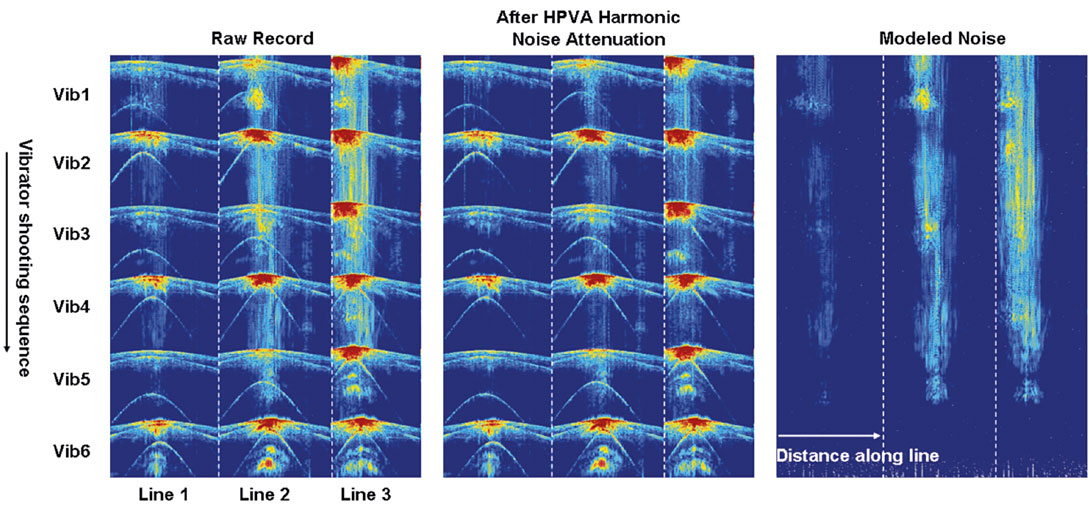
The conversion of a project from a conventional design to one utilizing the HPVA technique involves the evaluation of a number of parameters to optimize both productivity and data quality. Source effort, source-to-receiver ratios, target depths, slip times and desired signal-to-noise levels all play a key role in determining the final design. The manipulation of these parameters can provide a variety of options for the client. Improved image quality, a reduction in acquisition cost, and/or reduced project cycle time are all possible benefits.
V1 Single-Vibrator Acquisition
Slip-sweep and HPVA demonstrate how vibroseis acquisition can be made more efficient. The next step to consider is reducing the source array size. The obvious answer is to reduce the number of vibrators in the fleet.
CGGVeritas reduced the fleet to a single unit and introduced V1 single vibrator acquisition (Meunier et al, 2007). V1 acquisition comprises a larger number of smaller fleets of vibrators covering a dense grid of shotpoints and provides the next step-change in source productivity.
Production rates of 600VP/hr have been recorded on CGGVeritas crews in the Middle East, opening the way to high-density wideazimuth acquisition. This brings the benefit of improved image quality via better illumination, better multiple suppression and better azimuthal amplitude and velocity information.
When implementing V1, source power and signal amplitude can be compensated by increasing the sweep length of the single vibrator and by increasing the density of the shot points.
A new concept in vibrator fleet management has been introduced providing a robust and efficient operation. The vibrators are now automatically allocated slots in a shooting schedule and move independently on their designated shot lines. If a vibrator falls behind and misses its slot, it waits for the next available slot. At any given time in a nominal 12-vibrator schedule, up to eight vibrators are sweeping concurrently while four are moving to the next shot points and preparing to sweep.
The system is very flexible as illustrated in Figure 2, allowing quick modifications to the shooting schedule and redeployment of individual units to cover for a source failure or add additional effort where needed. Positional and QC information are shared with the vibrator fleet manager and the recording truck through the utilization of GPS navigation and “stake-less surveying” technologies. This optimizes vibrator efficiency and helps to ensure adherence to permitted areas and designated exclusion zones.
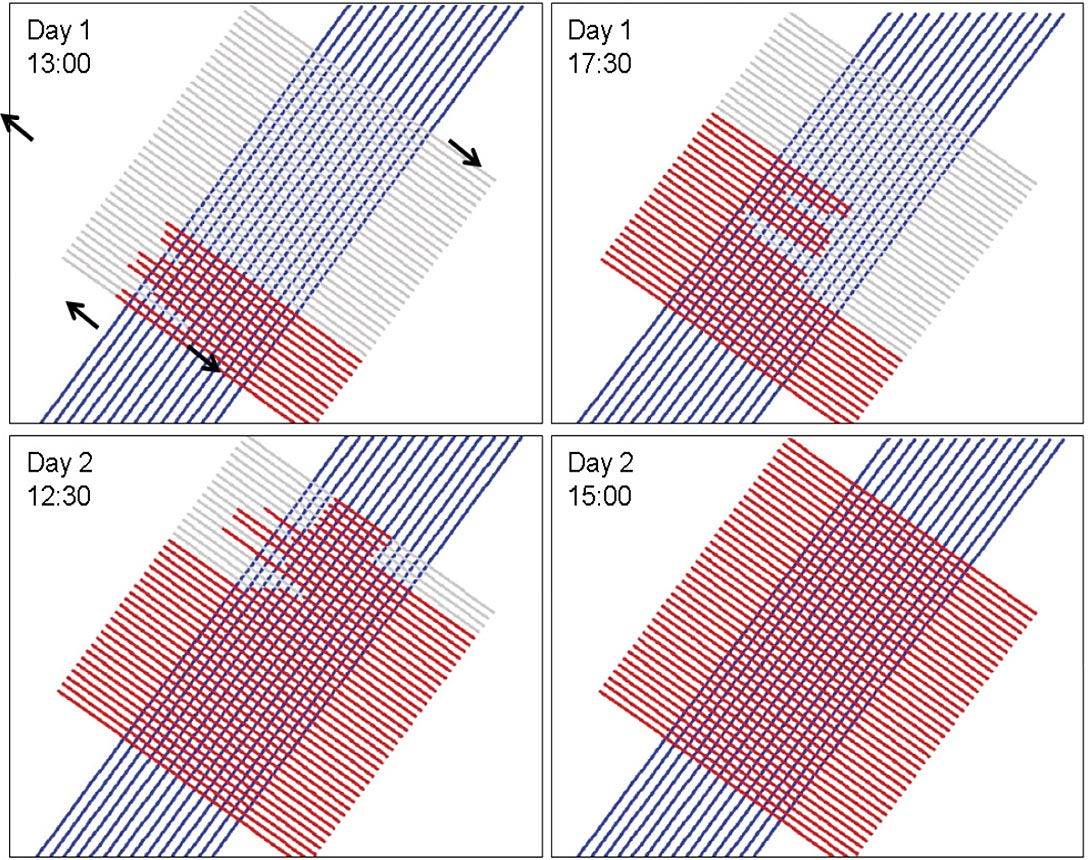
Data Examples
HPVA and V1 technologies are important vehicles for improving the spatial sampling of 3D surveys for enhanced subsurface imaging and resolution in a cost-effective manner. A number of authors including Egan et al (2008), Long (2004) and Meunier et al (2008) provide both theoretical and real data support for improved imaging. In addition, many papers make the case that point source/point receiver acquisition provides decided benefits.
HPVA was developed and has enjoyed considerable success in the Middle East. The first North American HPVA production dataset was acquired in the northern United States in late 2008. In conjunction with the 648 km2 HPVA 3D acquisition project, 2D test data were acquired to compare conventional and HPVA methods. Figure 3 provides a 2D comparison of conventional data (6 x 8 second sweeps) and HPVA data (1 x 48 second sweep with a 28 second slip time). Even with a comparatively short slip time, the harmonic energy has been successfully mitigated and very comparable images produced.
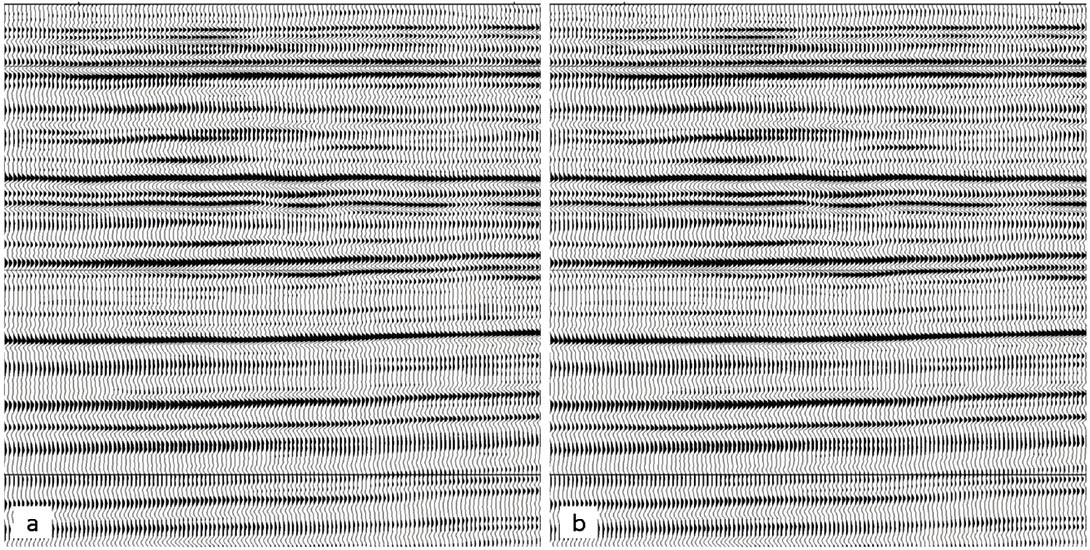
The associated production HPVA 3D dataset utilized three sets of four vibrators and costeffectively increased the trace density in excess of 33% relative to conventional acquisition. For future work in this project area, the intent is to move to two vibrators per fleet, further increase the number of source points, and modestly increase the sweep time.
Figures 4 and 5 show sections comparing datasets using sets of four vibrators per fleet and one vibrator per fleet. The singlevibrator acquisition employed denser source sampling and increased sweep time to approximately preserve signal-to-noise versus the four-vibrator fleet. In Figure 4, note the improved image resolution and coherency when both inline source intervals and source line intervals are halved. Figure 5 shows that a move to single-vibrator acquisition with only a halving of the source line interval (and increased sweep time) produces a nearly 60% increase in productivity while still achieving an improvement in image quality.
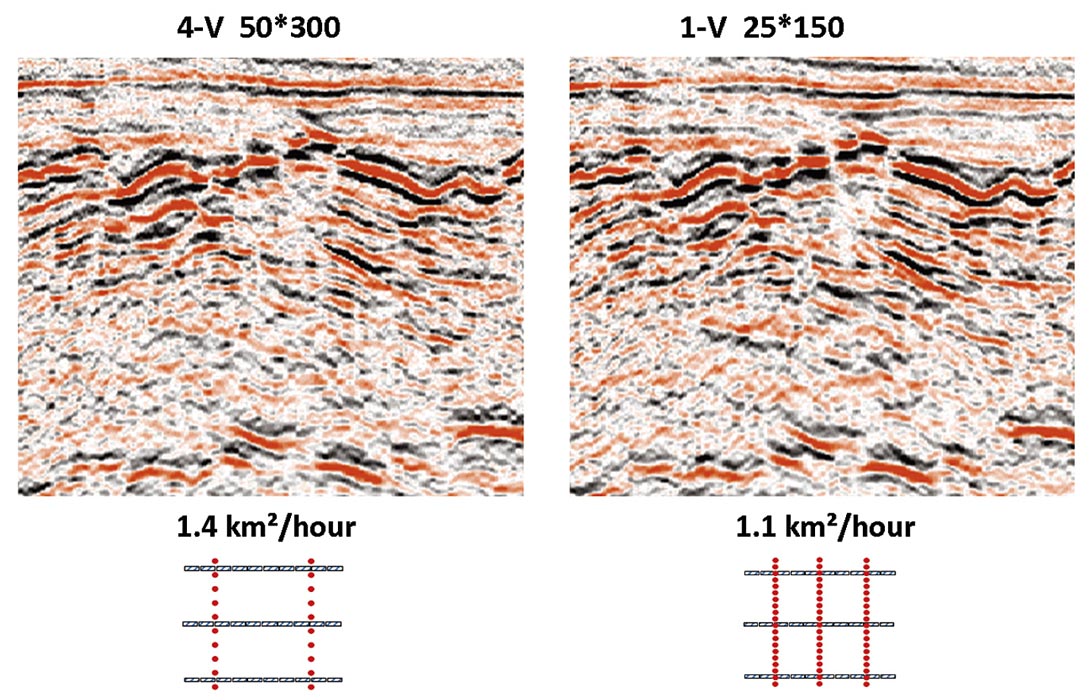
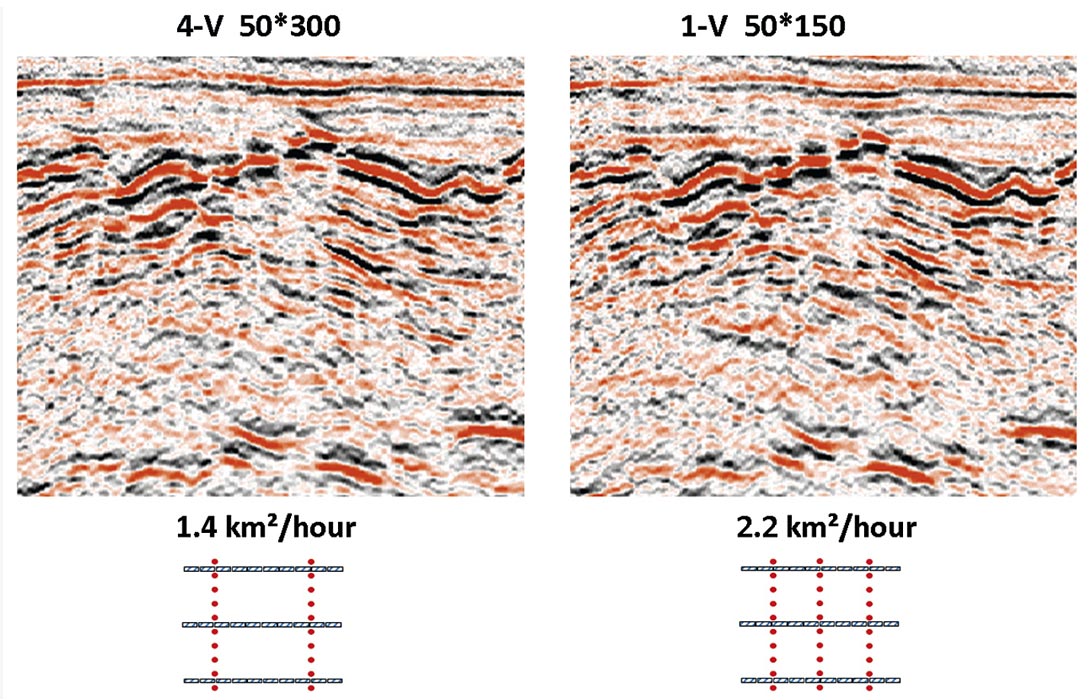
Figure 6 provides an example of the reduced acquisition footprint achievable through denser spatial sampling (Bianchi et al, 2009). Further to this, Sambell et al (2009) describes the incredible improvement in image quality that can result from multiplying conventional trace density by a factor of nearly 100 by using a cost-effective highperformance vibroseis “super-crew”.
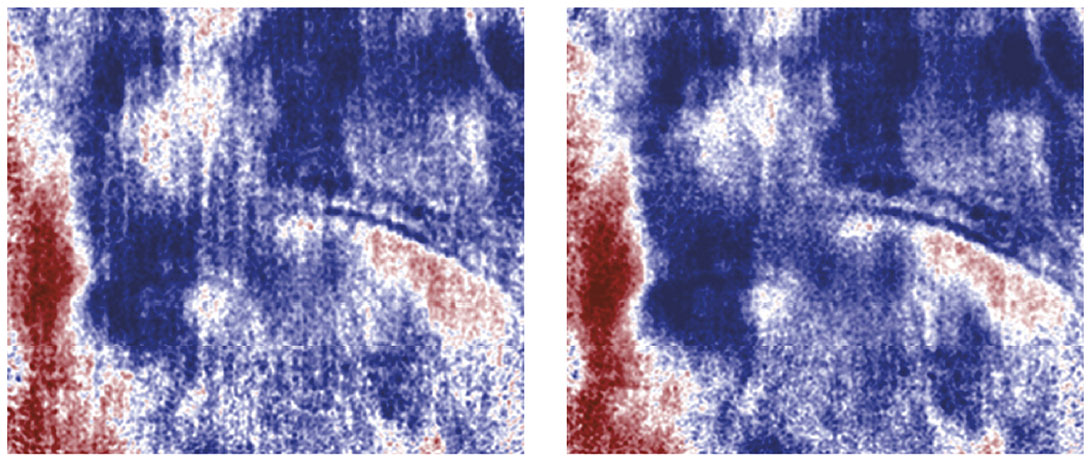
Moving Forward
High channel-count recording systems readily allow us to increase receiver density. We should now be looking at increasing source density to further improve the spatial sampling of our surveys. With a properly sampled wavefield, both signal and coherent noise, we can realize clear benefits in image quality and noise attenuation. But how can we increase source density economically?
As with all data acquisition methods we need to choose the most appropriate tools for the geophysical goals. Consideration of a number of factors including logistical, environmental, regulatory, financial and ultimately image quality, must be evaluated. The project environment will ultimately dictate which method is used. We should, however, recognize the need to start using techniques that will move us away from an emphasis on “good” shot records and toward better statistical sampling, important for effective data processing. HPVA and V1 technologies are proven tools we can use to realize improvements in image quality while maintaining an economic project budget.

Acknowledgements
The authors would like to thank Apache Corporation and Samson Resources for their contributions and would also like to acknowledge the efforts of the CGGVeritas joint venture Ardiseis in pioneering the testing and deployment of HPVA and V1 in the Middle East.











Join the Conversation
Interested in starting, or contributing to a conversation about an article or issue of the RECORDER? Join our CSEG LinkedIn Group.
Share This Article